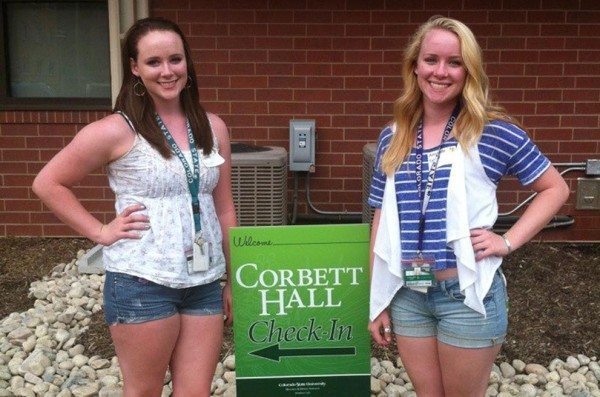Last updated on July 1st, 2024 at 04:40 pm
Do you remember how overwhelmed you felt preparing for the birth of your multiple birth children? You had many questions. What equipment will they need? Do I need two of everything? Breast or bottle? Cloth or disposable? Then they started school and there were more questions. Public, private, or home school? Keep them together or separate them? As your multiples approach college-age, those questions don’t cease; they just become a new set of questions.

I became a single mother at the start of my twin daughters’ senior year of high school and fully shouldered the daunting task of their college application and preparation process. It was truly a “baptism by fire.” I’m proud to report that they have successfully completed their sophomore year in college, and I will be starting the process all over again with my son, who will be a high school senior in the fall.
The task may be daunting but it doesn’t have to totally overwhelm you. Thankfully, there’s lots of information on the Internet. I could probably write a book on the subject, but my intent is to provide you with some of the basic information that I sought out as I was going through the process.
Community College, State College, or Private University?
The answer to this question will depend on many factors including your child’s high school academic successes, standardized test scores, choice of college major, future interests, your family’s household budget and the ability to contribute towards college costs, whether your children will live on or off campus, etc. Start flushing out these factors early in the high school years so you and your children will be fully prepared for the application process come junior and senior year.
Together or Separate?

And you thought you graduated past this question when your multiples left their elementary years! Not necessarily. When my twins started the college search process they both stated they didn’t want to go to the same school. Their argument… “We’ve been together for 18 years – we want to be apart!” This surprised me because when given the choice during elementary and middle school, they always wanted to be together. With this in mind, we visited several colleges (in and out of state). Ultimately, our state university turned out to be most affordable and they were both able to qualify for scholarships and grants. They have never regretted the decision and with two very different majors, they hardly see each other on campus.
Standardized Tests
- PSAT/NMSQT: Administered fall of the sophomore year of high school at some schools and fall of the junior year at all schools, the Preliminary SAT/National Merit Scholarship Qualifying Test provides firsthand practice for the SAT. It also gives students a chance to enter NMSC scholarship programs and gain access to college and career planning tools.
- SAT: Most students take this in the spring of their junior year, and many students take it again in the fall of their senior year.
- SAT II (AKA SAT Subject Tests): These can be taken every time the SAT is offered except for the March/April test. The SAT and the SAT Subject Tests cannot be taken in the same day.
- ACT: Usually taken during the spring of the junior year so students will have their test scores and other information in time to help them plan their senior year. The ACT follows the same schedule as the SAT except that students can pick and choose which scores they want to send to colleges.
Registering and paying for these standardized tests is easy and can be done online. Additionally, students have the opportunity to retest if they feel their initial scores didn’t accurately reflect their abilities in the areas they tested. Students can practice for the tests buy purchasing The Official SAT Study Guide and The Real ACT Prep Guide.
College Visits

Once you’ve narrowed down your list of potential colleges to two or three, start scheduling visits. For my girls and me, spring break of their junior year was a great time for this. While we were not able to observe campus life with students actually “in” classes (because the colleges were also on spring break during that time), we were able to get a very clear picture of college life, academic programs, tour the dorms, etc. We actually visited four campuses and my girls quickly narrowed down their college choices to two. Check each college’s website for information about tours. They schedule group tours at various times during the year. Also get on their mailing list so you can be kept apprised of application deadlines, scholarship opportunities and deadlines, campus happenings, etc.
Applications
Be prepared. This can get expensive if you are applying to more than one school. Check the school’s website for fees associated with applying, deadlines, required documents, test scores, etc. Fortunately, many colleges and universities have gone completely digital in their application process making it a little less daunting. Colleges and universities use fairly standard definitions to describe each form of an application, which makes it easier for students to understand the differences between each university’s programs.

Many colleges and universities participate in The Common Application, a not-for-profit membership organization that serves students, member institutions, and secondary schools by providing applications that students and school officials may submit to any of their over 500 members. When using the Common Application, you can create one application (per child) and submit it to multiple colleges (provided the college or university is a participating member), and even pay the application fees right online.
If your child is interested in attending a military academy, that process needs to be started early in the junior year of high school. Be prepared, it is a tedious process. Both my girls applied to and were accepted at the Air Force Academy. One received a congressional recommendation—the other did not. While they both decided to attend their state university, I was glad they went through the Air Force Academy application process. It was a learning experience and the interview conducted by community leaders gave them a taste of the “real world” of being an adult.
Application Essays
Your college applicant will be required to submit an admission essay with their application. This is how the college or scholarship provider gets to know them. They should make this essay personal and free from grammatical errors. Check out the 10 Tips for Writing the College Application Essay on U.S. News.com. Also check out the personal essay tips on Collegeapps.about.com.
College Financing

Once you have narrowed down your school(s) of choice, it’s time to start looking into college financing. There are so many options including scholarships, grants, student loans, parent loans, work study, etc. The best place to start this educational process is at the respective colleges’ websites. They provide links for scholarship and grant opportunities, state-sponsored opportunities, and the Free Application for Federal Student Aid (FAFSA), where you can apply for federal grants, loans, and work-study funds.
The FAFSA is now also an online application and you will be required to complete a FAFSA for each child; but they offer a great feature that allows you to copy all the information you submit over to additional children in the family.
College Scholarships for Multiples
Multiples.about.com provides information about opportunities for college tuition assistance in the form of scholarships specifically for multiple birth children.
Together or Separate?
AGAIN with the together or separate question? Yes, sorry.
If your multiples end up at the same college or university, you will need to discuss their housing options. My girls’ university required that freshman live in the dorms. My twins decided to have roommates randomly assigned to them so they could meet new people and fully experience college life. Check out the colleges’ websites regarding housing requirements, costs, the application process, roommate selections, etc. Many colleges will allow students to apply to be Resident Assistants (RAs) in their sophomore year. This is a great opportunity for your child to cut housing costs while also taking on some leadership responsibilities.
My girls had a very successful and fun dorm experience their freshman year, including making lots of new friends, getting involved in group functions, etc. They decided to get an apartment together their sophomore year and are rooming together (again) along with one of their best friends from high school. They will not be rooming together junior year.
Living in the Dorms

What will they need? What can they live without? Start a list and start it now! My girls brought way too much stuff to the dorm their freshman year and I ended up bringing a lot of it back home.
Here are some links to just a few of the many college packing lists you can find online. Check them out and then create a personalized packing list for your children.
Be prepared for the expense. It cost me $300 per child to get my girls set up with linens, toiletries, cosmetics, non-perishable food and drinks, eating utensils, electronics, cleaning supplies, etc. for their dorm rooms.

Additional Expenses
You’ll want to consider the following additional expenses when making college choices:
- Meal plans (most colleges offer several different plans with varying costs)
- Parking (my twins opted not to take their car to college freshman year because they were on campus all the time and the parking fees were too high. Instead, they brought their bikes. There even ended up being a $25 “bike registration fee” that we had not planned for).
- Health insurance. If your children will not continue to be covered under your family plan, you’ll want to see if the college offers student insurance.
- Books and supplies
- Check out Slugbooks.com to buy, rent and sell textbooks.
- Campus Book Rentals offers new and gently used textbooks for typically less than half the price paid in school bookstores. They also offer RentBack, an initiative that allows students to rent the textbooks they own—to other students—and earn money.
- Travel expenses to come home on breaks and over the summer. Most colleges don’t allow students to remain in the dorms over the summer months so your children will have to move their belongings out of the dorms and either into storage or back into your home.
By the time your multiple birth children are college-aged they’ll have completed many monumental tasks and you’ll have survived a variety of seemingly insurmountable challenges. Preparing your children for college is just one of an assortment of important roles you’ll play in their lives over the years. You’ll perform those roles best if you are well informed so continue gathering information and asking questions, and hopefully your children will give you a break for a few years before they start asking you for advice on parenting their own children! Best of luck to each of you!

Donna May Lyons is a single mother of 20-year-old fraternal twin daughters and a 17-year-old son. She is pleased to report that after twenty years of parenting multiples plus one, her parenting motto is finally “Semper Gumby Omni Nocte Dormiens” (Always Flexible with a Full Night of Sleep). You can connect with Donna May on Facebook and Twitter.
Resources for College Admissions
- Steps for the United States Military Academies Application Process
- The National Association for College Admission Counseling (NACAC) – Nearly 13,000 professionals from around the world dedicated to serving students as they make choices about pursuing postsecondary education. Offering extensive resources for students and parents.
- College Navigator – A resource of the U.S. Department of Education. College Navigator gathers admission, retention, graduation, and financial aid data for every college in the country.
- You Can Go – A College Board project connecting students with success stories about preparing, applying, and paying for college.
- SR Education Group – An organization striving to be the most authoritative online resource to help students choose the best school for their career aspirations and budget. You can find their list of 2014 Most Affordable U.S. Online Colleges on their website.
- Scholarships Trending Now – A great list of scholarships trending now at Scholarship.com.
- Scholarship.com – A website filled with well-researched and thorough information for searing, finding, and applying for scholarships, grants, and financial aids. You can also search colleges, find your best fit, and receive notifications on new scholarships. They even offer an iPhone and Android app.
Find Scholarship Contests and Sweepstakes, and Scholarships Sorted By:
- Grade Level
- Major
- State
- Type
- Sports
And Scholarships For:
- Women
- Minorities
- First In Family/First Generation

Need some twin parent friends? Get the support you need with a Twiniversity Membership. Benefits include a monthly twin parent club meeting on Zoom, access to a private Facebook group just for twin parents, and a video library of twin parenting lessons. Visit Twiniversity.com/membership to join today!

Twiniversity is the #1 source for parents of
multiples, and we are growing faster every day!
Find us all over the web:
Or contact us by email at community@twiniversity.com







